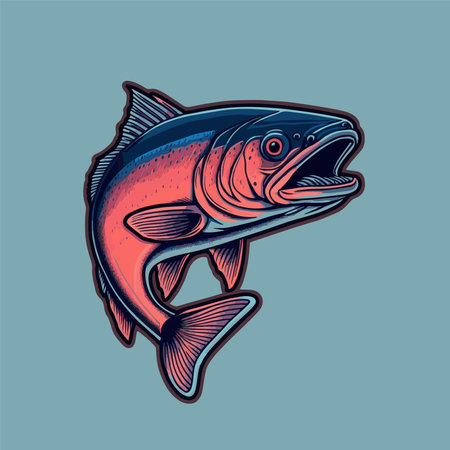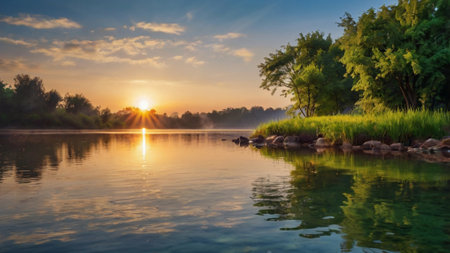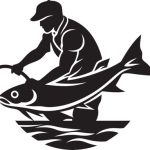Introduction to Trout Fishing in Maine
When it comes to trout fishing, Maine stands out as one of the premier destinations in the United States. Known for its rugged beauty and untouched wilderness, the Pine Tree State offers anglers a unique blend of adventure, solitude, and world-class trout fishing. From remote mountain streams to crystal-clear lakes, Maine’s waters are teeming with brook trout—the only native trout species in the Northeast and a favorite among fly fishers.
What makes Maine so special for trout fishing? Its all about location and environment. The state boasts thousands of miles of cold-water streams and spring-fed brooks that provide ideal conditions for wild brook trout to thrive. These cool, oxygen-rich waters run through dense forests and unspoiled terrain, creating perfect habitats for both the fish and those seeking a back-to-nature experience.
Why Anglers Love Maine
Maine’s commitment to conservation has helped preserve its trout populations over generations. Strict regulations, such as catch-and-release zones and protected watersheds, ensure healthy fish numbers and sustainable fishing practices. This dedication makes every trip feel like you’re stepping into nature’s best-kept secret.
Top Reasons to Fish for Trout in Maine
| Reason | Description |
|---|---|
| Abundant Brook Trout | Maine has one of the healthiest wild brook trout populations in the U.S. |
| Remote Wilderness Streams | Thousands of miles of off-the-grid streams offer peaceful angling experiences. |
| Cold, Clean Water | Ideal water temperatures support year-round trout activity. |
| Scenic Landscapes | Mountain views, forested riverbanks, and quiet lakes add to the charm. |
| Diverse Fishing Options | From fly fishing small creeks to trolling larger lakes—theres something for everyone. |
Did You Know?
Maine is home to over 97% of the remaining native Eastern brook trout habitat in lakes and ponds within the U.S.—a fact that draws serious anglers from across the country each season.
If youre looking for clear water, wild fish, and a true wilderness experience, then trout fishing in Maine should be on your bucket list.
2. Best Wilderness Streams for Brook Trout
Dive into some of Maine’s most secluded streams and rivers, known for their pristine waters and exceptional brook trout fishing opportunities. These wild waters offer a peaceful escape for anglers who love the challenge and reward of chasing native brookies in remote locations.
Top Remote Streams for Wild Brook Trout
Whether youre hiking deep into the woods or paddling through quiet backcountry, these streams are perfect for those looking to connect with nature and land a few beautiful brook trout along the way.
Katahdin Woods and Waters National Monument
This lesser-known gem is home to miles of untouched streams that flow through dense forests and rugged terrain. Anglers can expect cold, clear waters and plentiful wild brook trout. Bring your waders, as access often requires a bit of walking off-trail.
Nesowadnehunk Stream
Flowing near Baxter State Park, Nesowadnehunk Stream is a favorite among fly fishermen. The stream offers consistent cold-water conditions that are ideal for native brook trout throughout the season. Dry flies and small nymphs work well here.
Moose River Tributaries
The Moose River watershed in western Maine holds several hidden tributaries where brook trout thrive. These smaller waters require stealth and finesse but offer some of the best chances at catching colorful wild trout away from crowds.
Roach River
Located near the eastern side of Moosehead Lake, the Roach River is known for its strong brook trout population, especially during spring and fall runs. The river features deep pools, undercut banks, and plenty of structure to hold fish.
Recommended Gear for Backcountry Brook Trout Fishing
| Gear | Description |
|---|---|
| Fly Rod (3-5 wt) | Ideal for delicate presentations in small streams |
| Lightweight Waders | Essential for navigating cold water in remote areas |
| Tenkara Rod (Optional) | A great ultralight option for minimalists |
| Dry Flies & Nymphs | Go-to patterns include Adams, Elk Hair Caddis, Pheasant Tail Nymphs |
| Bug Spray & Map | Maine’s wilderness is buggy—be prepared and don’t get lost! |
Tips for Exploring These Remote Streams
- Plan Ahead: Cell service is spotty in many areas—download maps offline.
- Respect Wildlife: Youre in moose country; give animals space.
- Leave No Trace: Pack out everything you bring in.
- Fish Early or Late: Low-light hours often produce more action.
Maine’s wilderness streams offer a rewarding experience for any angler willing to venture off the beaten path. From crystal-clear brooks in thick forests to rocky rivers below mountain ridges, these waters are where brook trout still thrive as they have for generations.

3. Top Lakes and Ponds for Trout Anglers
Maine isn’t just about winding streams and backcountry brooks — the state is also home to some incredible lakes and ponds that are prime spots for trout fishing. These waters offer both easy access for casual anglers and remote options for those looking to escape into nature. Whether you’re fly fishing from shore or trolling from a boat, these lakes and ponds provide excellent opportunities, especially during the cooler months of spring and fall when trout are most active.
Moosehead Lake
As Maine’s largest lake, Moosehead Lake is a must-visit destination for serious trout anglers. Located in the northwestern part of the state, this lake is known for its cold, deep waters that support healthy populations of lake trout (togue) and brook trout. Spring ice-out season is especially productive, as trout move into shallower waters to feed.
What Makes It Special:
- Abundant lake trout and native brook trout
- Scenic wilderness setting with low fishing pressure
- Great access points around Greenville
Rangeley Lakes Region
The Rangeley Lakes area is legendary among trout enthusiasts. This region includes several interconnected lakes — such as Rangeley Lake, Mooselookmeguntic Lake, and Cupsuptic Lake — all teeming with brook trout and landlocked salmon. The cool, clear waters make it ideal habitat for these species year-round, but fall offers some of the best action as fish prepare for spawning.
Top Lakes in the Rangeley Area:
| Lake | Main Species | Best Seasons |
|---|---|---|
| Rangeley Lake | Brook Trout, Landlocked Salmon | Spring, Fall |
| Mooselookmeguntic Lake | Brook Trout, Salmon | Spring, Fall |
| Cupsuptic Lake | Brook Trout | Fall |
Kennebago Lake
If youre after trophy-size wild brook trout, Kennebago Lake should be on your radar. Access is more limited here due to private lands, but guided trips can get you onto this pristine waterbody. Fly fishing is king here, with many anglers using traditional Maine streamers to tempt large trout.
Kennebago Highlights:
- Catch-and-release regulations help maintain big fish populations
- No motorized boats allowed — perfect for quiet angling experiences
- A great spot for dry fly fishing in late spring and early summer
Maines lakes and ponds offer something for everyone — from seasoned pros chasing trophies to weekend warriors looking to relax by the water. With cold, clean waters full of native trout species, these hotspots are truly worth exploring during your next fishing adventure.
4. Local Tips and Tactics for Catching Brook Trout
When it comes to landing big brook trout in Maine’s wilderness streams, local anglers have developed time-tested techniques that consistently deliver results. Whether youre a seasoned fly fisher or just starting out, using the right flies, bait, and seasonal strategies can make all the difference.
Fly Patterns That Work in Maine
Maine’s brook trout are known to be aggressive feeders, especially during spring and fall. Fly fishing is extremely popular here, and certain patterns have become go-to choices for locals.
| Fly Pattern | Type | Best Time to Use | Why It Works |
|---|---|---|---|
| Woolly Bugger (black or olive) | Streamer | Spring & Fall | Mimics small baitfish; great for active trout in moving water. |
| Adams | Dry Fly | Late Spring to Early Summer | A classic dry fly that imitates many mayflies seen in Maines streams. |
| Pheasant Tail Nymph | Nymph | Year-round | Versatile pattern that looks like common aquatic insects. |
| Hornberg Special | Wet Fly/Streamer | All Seasons | A traditional Maine favorite; works well swung through current. |
| Muddler Minnow | Streamer | Fall | Effective when trout are feeding on sculpins and small fish. |
Bait Choices Beyond the Fly Rod
If you’re not fly fishing, don’t worry—there are plenty of effective natural and artificial baits that work wonders on brookies in Maine. Just be sure to check local regulations, as some waters are fly-fishing only or have specific bait restrictions.
Top Natural Baits:
- Worms: Especially nightcrawlers—great under a bobber in pools or slow runs.
- Minnows: Alive or dead—drifted in current or still-fished near structure.
- Salmon Eggs: Excellent in colder months when trout target egg patterns naturally.
Popular Artificial Baits:
- PowerBait Nuggets (salmon egg scent): Effective in stocked waters.
- Small spinners (like Panther Martin or Mepps): Great for covering water quickly and triggering reaction strikes.
- Spoons (1/8 oz): Flashy presentation that draws out bigger fish from deeper pockets.
Seasonal Strategies from Local Anglers
The time of year plays a major role in how and where to fish for brook trout in Maine. Here’s how experienced locals approach each season:
| Season | Tactics & Locations |
|---|---|
| Spring (April–June) | The ice-out period is prime time. Focus on stream mouths, inlets, and shallow riffles. Fish are hungry after winter and respond well to streamers and worms. |
| Summer (July–August) | The bite slows down during heat waves. Target shaded areas, spring-fed brooks, and deeper pools early morning or late evening using dry flies or nymphs. |
| Fall (September–October) | This is trophy season. Brook trout spawn during fall, becoming more aggressive. Use brightly colored streamers or egg patterns near gravel beds and undercut banks. |
| Winter (November–March) | Icy conditions limit access. Some anglers ice fish with jigs tipped with bait where legal. Be cautious of thin ice and always check regulations before heading out. |
A Few Extra Tips from the Locals:
- Always approach quietly—brook trout spook easily in clear water.
- Kneel or crouch when casting near small streams to avoid being seen by fish.
- If one fly isn’t working, switch it up—brookies can be picky depending on the hatch.
- Maine law often requires barbless hooks in certain waters—check before you go!
- You’ll often find the best fishing spots off the beaten path—bring a map and get ready to hike!
With these tried-and-true tactics straight from Maine’s most experienced anglers, you’ll be better prepared to hook into some unforgettable brook trout this season. Happy fishing!
5. Regulations and Conservation in Maine’s Trout Waters
Before you cast a line into Maine’s wild trout streams, it’s important to understand the rules that keep these waters healthy and thriving. The state has put strong regulations in place to protect its native brook trout populations—some of the best in the lower 48 states.
Fishing Licenses
Anyone aged 16 or older needs a valid Maine fishing license to fish in freshwater. You can purchase licenses online through the Maine Department of Inland Fisheries and Wildlife, or at local sporting goods stores, town offices, and even some convenience stores.
Size and Bag Limits
Maine enforces strict size and bag limits depending on the water body. These limits help ensure that trout populations remain sustainable for future generations. Heres a general idea of what to expect:
| Species | Minimum Length | Daily Bag Limit |
|---|---|---|
| Brook Trout (in lakes/ponds) | 6 inches | 5 fish (only 1 over 12″) |
| Brook Trout (in rivers/streams) | No minimum | 5 fish (only 1 over 12″) |
| Brown/Rainbow Trout | 14 inches | 2 fish combined total |
Catch-and-Release Zones
Certain areas in Maine are designated as catch-and-release only, especially in waters known for wild or native brook trout. These rules mean you must release all trout immediately after catching them—no exceptions. These zones are clearly marked by signs or listed in the state’s fishing law book.
Conservation Efforts
Maine is serious about protecting its native trout habitat. Conservation efforts include:
- Special Regulations: Some remote ponds and streams have gear restrictions like fly-fishing only or artificial lures only to reduce fish mortality.
- Habitat Protection: The state works with conservation groups to maintain clean, cold-water environments essential for brook trout survival.
- Stocking Programs: While many waters support wild populations, others are stocked carefully to balance angler access with ecological health.
Tip for Anglers:
Always check current fishing regulations before heading out, as rules can change from year to year and vary by location. You can find up-to-date info in the official Maine Fishing Law Book or on the state website.
If you respect the regulations and do your part in conservation, youll not only enjoy better fishing—but also help preserve Maine’s incredible trout legacy for years to come.
6. Planning Your Trout Fishing Adventure in Maine
If youre ready to cast a line into Maine’s legendary trout waters, some smart planning can make your trip smoother and a lot more fun. Whether you’re going solo or bringing the whole family, here’s what you need to know about guided services, gear rentals, timing your visit, and where to stay near top fishing locations.
Guided Tours and Local Outfitters
Hiring a local guide can really enhance your experience—especially if it’s your first time exploring Maine’s backcountry streams. Guides not only know where the fish are biting, but they also help with techniques, safety, and local fishing regulations. Most guides offer half-day or full-day trips and cater to all skill levels.
Popular Guide Services in Maine
| Guide Service | Location | Specialties |
|---|---|---|
| Maine Wilderness Guide Service | Greenville | Remote brook trout streams, fly fishing instruction |
| Kennebec River Angler | Bingham | Float trips, river wading for trout and salmon |
| Rangeley Region Sport Shop | Rangeley | Classic trout waters, custom day trips |
Gear Rentals and Tackle Shops
If you don’t want to haul all your fishing gear from home, no worries—many outfitters across Maine rent rods, reels, waders, and even fly selections tailored to local hatches. You’ll also find helpful advice from staff who fish these spots daily.
Recommended Tackle Shops for Gear Rental
- L.L.Bean Outdoor Discovery Schools (Freeport): Offers rental packages and beginner clinics.
- Northwoods Outfitters (Greenville): Fly rods, spinning gear, and guided day trips available.
- Naples Bait & Tackle (Naples): Gear rental plus live bait for spin anglers.
Best Times to Visit for Trout Fishing in Maine
Maine’s trout season runs from April through September, but timing matters depending on where youre headed. Early spring is great for active brookies in smaller streams, while summer offers prime dry-fly action in higher elevation areas. Fall brings beautiful foliage and aggressive fish prepping for winter.
Maine Trout Fishing Seasons at a Glance
| Season | Conditions | Recommended Locations |
|---|---|---|
| April – May | Cold water; hungry post-winter trout | Kennebec River headwaters, Moosehead Lake tributaries |
| June – August | Mild weather; best dry-fly activity | Rangeley Lakes Region, Rapid River area |
| September – October | Crisp air; pre-spawn aggression in brook trout | Northern wilderness streams, remote ponds near Baxter State Park |
Lodging Near Top Trout Spots
You’ll find everything from rustic cabins to cozy inns near Maines best trout waters. Some even offer fishing packages that include meals and guide services.
Lodging Options by Region
| Name | Region | Amenities |
|---|---|---|
| The Birches Resort | Moosehead Lake Area | Lakeside cabins, boat rentals, guided trips available onsite |
| Loon Lodge in the Forks | Kennebec Valley Region | Lodge rooms & cabins, river access, private fishing spots nearby |
| The Rangeley Inn & Tavern | Rangeley Lakes Region | Historic inn with modern comforts near classic fly-fishing waters like the Magalloway River |
A Few Quick Tips Before You Go:
- Packing: Bring bug spray (black flies are no joke), layers of clothing for unpredictable weather, polarized sunglasses, and waterproof boots.
- Licenses: Don’t forget to purchase a Maine fishing license online or at most sporting goods stores.
- Sustainability: Practice catch-and-release when possible and follow local regulations to help preserve Maine’s wild trout populations.
Maine offers an unforgettable experience for every trout angler—from seasoned fly-fishers to first-timers exploring the outdoors. With a little planning ahead of time, you’ll be ready to dive into one of America’s finest freshwater fishing adventures.

